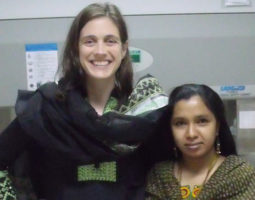Alumni Spotlight
The Human Connection
A UW Medicine alumna connects studying health with delivering care.
 What do a family medicine practitioner and a global health researcher have in common? Just ask Maegan Ashworth Dirac, M.D. ’14, Ph.D. ’12 — she’s both. For Dirac, a typical week’s work will involve writing computer code, analyzing public health data and maybe even delivering a baby.
What do a family medicine practitioner and a global health researcher have in common? Just ask Maegan Ashworth Dirac, M.D. ’14, Ph.D. ’12 — she’s both. For Dirac, a typical week’s work will involve writing computer code, analyzing public health data and maybe even delivering a baby.
If you think these sound like mutually exclusive activities, you’re not alone. “People generally don’t picture family medicine as a discipline that lends itself to research,” says Dirac.
Dirac is a graduate of UW Medicine’s Medical Scientist Training Program — an educational track, also called an M.D.-Ph.D. program, designed to appeal to people interested in both medicine and research. It was a good fit for Dirac, but it puzzled some of her peers.
“Researchers didn’t always understand why I wanted to do family medicine,” she says. “They respected clinicians, but thought it would be hard to stay expert in both areas.” But for Dirac, who studied epidemiology, clinical care adds the human connection that makes her a better researcher. “Being a clinician helps you understand the diseases that you’re trying to study,” she says.
Today, Dirac spends most of her time at the Institute for Health Metrics and Evaluation (IHME), working on the annual Global Burden of Disease study, which coordinates data from nearly 3,700 collaborators in nearly 150 nations to make it easier to compare diseases across time, age groups and populations. “We’re making all the data talk to each other, so we can define the burden of disease in a way that takes into account how many people have a disease and disease severity,” Dirac says.
Crunching numbers and writing computer code at IHME takes up four days a week for Dirac, and her research helps patients by informing healthcare decisions around the world. “It’s really exciting to do things that have such clear implications,” she says. “What we publish is used to make decisions about how to spend health funds in countries worldwide.”
Her fifth day is spent floating at HealthPoint’s community health centers throughout south King County; Dirac will soon be joining the on-call OB pool at St. Francis Hospital in Federal Way, too. And she hopes to serve as a role model for future clinician-researchers: This fall, Dirac is hosting a Student-Alumni Informational Discussions (SAID) dinner, where she’ll share ideas and inspiration with medical students thinking about their own futures in the field.
“I feel what I do at IHME and in global health — having a perspective on the natural course of an illness, on how people convalesce, and what’s hard about having these diseases — leads to invaluable insights,” says Dirac. “I’d love to help encourage the development of more researchers who are also family physicians.”

